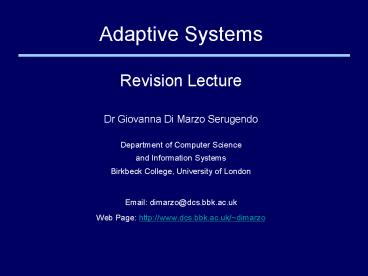Adaptive Systems Revision Lecture PowerPoint PPT Presentation
1 / 19
Title: Adaptive Systems Revision Lecture
1
Adaptive SystemsRevision Lecture
- Dr Giovanna Di Marzo Serugendo
- Department of Computer Science
- and Information Systems
- Birkbeck College, University of London
- Email dimarzo_at_dcs.bbk.ac.uk
- Web Page http//www.dcs.bbk.ac.uk/dimarzo
2
Assessment
- Exam 70 (100 Marks)
- Coursework 20 (100 Marks)
- Presentation 10 (10 Marks)
- Exam
- June
3
Overall Picture
Adaptation Mechanisms
Natural Adaptive Systems
Engineering Adaptive Systems
Model State st
Artificial Adaptive Systems
Analysis and Simulation
4
Overview
- Natural Adaptive Systems
- Adaptation Mechanisms
- Artificial Adaptive Systems
- Models and Simulations
- Engineering
5
Natural Adaptive Systems
- Examples of natural adaptive systems
- Non-living world
- Living world
- Social behaviour
- Self-organisation
- Self-organisation is the process enabling a
system to change its organisation in case of
environmental changes without explicit external
command
6
Natural Adaptive Systems
- Emergent phenomena
- A structure (pattern, property or function), not
explicitly represented at the level of the
individual components (lower level), and which
appears at the level of the system (higher
level). - Positive / negative feedback
- Positive reinforcement of perturbation leading
to amplification of perturbation - Negative leads towards stabilisation by avoiding
fluctuations caused by perturbation
7
Natural Adaptive Systems
- Adaptation
- Adaptation to long-term environmental changes
- Adaptation to immediate environmental changes
- Individual components behave autonomously
- Local information (up-to-date)
- Immediate response of system
- Random fluctuations
- Adaptation expected for engineered systems
8
Adaptive Mechanisms
- Stigmergy
- Schools of fishes, flocks of birds
- Autopoiesis
- Trust
- Holarchy
- Market-based
9
Stigmergy
- Indirect communication among components of
self-organising system - Occurs through modifications brought by
individual components to their local
environment - Pheromone
- Chemical volatile substance
- Ants
- Work-in-progress
- Stimulus provided by previous work
- Wasps
- Stigmergy allows coordination without central
control
10
Schools of fishes
- Direct communication among components of
self-organising system - Schooling and Flocking
- Wave of reaction
- Communicated progressively to all components of
school, or flock - Need for
- Monitoring of position and speed of neighbours
- Adaptation of own position and speed
- Mechanism (attraction and repulsion rules)
- 1. Maintain a minimum distance from other objects
in the environment, including other
fishes/birds. - 2. Match velocities with neighbours.
- 3. Move toward the perceived centre of mass of
fishes/birds in its neighbourhood.
11
Models and Simulations
- Models
- Simple description of system
- Types of models mathematical definition,
computer-based model, cellular automata, neural
network - Simulations
- System whose behaviour represents certain
characteristics of the system we want to analyse - Interest
- Understanding natural system
- Defining and predicting artificial systems
- Experimentation
12
Artificial Systems
- Metaphors used
- Social insects, social human behaviour (gossip,
trust) - Biological systems (cells),
- Business and economics
- Holons
- Translation of metaphors into artificial system
- Artificial techniques
- Metadata
13
Artificial Systems
- Static Systems
- Static Problem solving
- Dynamic Systems
- Dynamic Problem Solving
- Trust-based systems
- Intrusion detection
- P2P Protocols
- Autonomic Computing
14
Engineering Overview
Engineering Adaptive Systems
15
Adaptation Mechanisms
- Translation of Natural Mechanisms
- Stigmergy
- Indirect communication through the environment
- Digital pheromone
- intensity, evaporation rate
- Work-in-progress
- mapping table configurations action
- Gossiping
- Informal discussion among entities
- Local exchange of information
- Neighbours list and Ranking function
- Gossip exchange and merging of information
- Update neighbours list
16
Adaptation Mechanisms
- Translation of Natural Mechanisms
- Trust
- Human trust in peers
- Trust values, calculation of risk, decision of
actions - Updated on basis of positive/negative evidence
- Immune System
- B cells antibodies (detection and marking)T
cells (destruction) - Bit strings (anomaly to detect)
- Mobile agents (B and T cells)
17
Adaptive Mechanisms
- Implementation of Artificial Mechanisms
- Tags
- Markings attached to individuals (agents) and
observable by others - Agents change behaviour on basis of utility
function value observed in peers (tag) - Metadata
- Additional information (metadata) about
functional / non-functional information /
policies - Middleware processes metadata and components
adapt to policies
18
Engineering
- Software Agents
- An agent is a computer system situated in some
environment, and that is capable of autonomous
action in this environment in order to meet its
design objectives - Middleware infrastructures
- Intermediary software layer
- Allow communication and coordination among agents
(entities) - Interest for decentralised adaptive systems
- Shared environment
- Agents coordinate their work through this
environment - No need for central control
- May support adaptation mechanism
19
Engineering
- Methodology
- Set of practices
- training materials, educational programs,
worksheets, diagrams - repeatedly carried out to produce software
- ADELFE Methodology
- Issues
- Interactions
- Management of uncertainty
- Design and development
- Micro- / Macro-behaviour
- Prediction of good/bad behaviour
- Control

